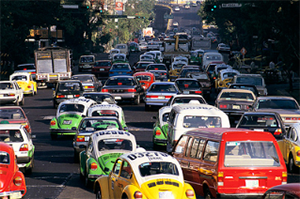 Many years ago in Bangkok, on my first World Bank mission, I made an error in judgment by taking a Tuk-Tuk, the ubiquitous three-wheeled "golf cart" taxi, in order to experience local transit patterns in a more intimate manner. At least that's how I retroactively justified what was nearly a fatal decision as the driver weaved in-between two buses which narrowly avoided squashing the tiny vehicle. What struck me more than anything at that time were the overall chaos of the transit system and the lack of safe mobility, unfortunately both quite common in a majority of low and middle-income countries which shoulder 90% of the world's road crashes.
Many years ago in Bangkok, on my first World Bank mission, I made an error in judgment by taking a Tuk-Tuk, the ubiquitous three-wheeled "golf cart" taxi, in order to experience local transit patterns in a more intimate manner. At least that's how I retroactively justified what was nearly a fatal decision as the driver weaved in-between two buses which narrowly avoided squashing the tiny vehicle. What struck me more than anything at that time were the overall chaos of the transit system and the lack of safe mobility, unfortunately both quite common in a majority of low and middle-income countries which shoulder 90% of the world's road crashes.
In this context, and to better assist countries achieve safer and cleaner mobility, the World Bank, in partnership with the Institute for Health Metrics and Evaluation (IHME), has issued a new report: Transport for Health: The Global Burden of Disease from Motorized Road Transport. The IHME is the home of the Global Burden of Disease study, widely considered among the preeminent global health metrics publications.
The Transport for Health report, for the first time, quantifies the global health loss from injuries and air pollution that can be attributed to motorized road transport. The results are stark and call for immediate action: deaths from road transport exceed those from HIV, tuberculosis, or malaria; together, road injuries and pollution from vehicles contribute to six of the top 10 causes of death globally. Moreover, road injuries are among the top-10 causes of death among women of childbearing age and the fourth leading cause among women aged 15-29.
While the World Bank-led Global Road Safety Facility already supports the UN Decade of Action for Road Safety 2011-2020, and the Rio +20 declaration towards a stronger sustainable transport system, this new report serves as a check-up on today's global challenges regarding both safer and cleaner mobility. From the Transport for Health report, a few key themes emerge that are essential for helping low and middle income countries develop safer and cleaner transport systems through a results-focused approach. These themes include:
- Long-term investment strategies for transit, along with greater institutional capacity to manage the complexities of a Safe System approach, are a must. A safe system approach accepts the fallibility of road users and creates a holistic, country-level road safety management system designed to generate positive and sustainable outcomes. Short-term thinking and "piece-meal" interventions, on the other hand, will invariably lead to unsustainable policies and results.
- Comprehensive frameworks and solutions that cut across sectors are critical. This applies both at the project level in client countries, and within the Bank itself: greater cooperation between the health and transport sectors will be essential to providing our clients with lasting, holistic solutions.
- More sophisticated research and institutional capacity to track the health impacts of road transport are crucial; that includes research on the potential dangers of exposure to traffic-related pollutants.
One thing is certain: with GDP loss from road crashes costing between 1-5% on average and as much as 8% or 10% for some nations, the challenge of achieving safer and cleaner mobility is playing a major role in determining the overall health and wealth of populations in low and middle-income countries. As World Bank President Jim Yong Kim himself notes in Transport for Health's foreword, "transport solutions that benefit the poor, create resilient economies, and save millions of lives" can be achieved. However, he also states this will require, in the case of meeting the UN Decade of Action goals, a “scaled up effort from the international donor community and governments worldwide.”
As non-communicable diseases and injuries are rapidly emerging as the major health burden of our time, outcomes will increasingly lie in such a scale up, and in our ability to transfer timely knowledge into complex and quickly shifting environments. Transport for Health reminds us of the stakes at hand.
Related:
- Global Road Safety Facility (GRSF)
- Institute for Health Metrics and Evaluation (IHME)
- Report: Transport for Health, the Global Burden of Disease from Motorized Transport
- Feature Story: Taking on the Rising Death Toll from Traffic & Pollution
- Press release: Safer, Cleaner Transport Crucial for Improving Global Health, Report Shows


Join the Conversation